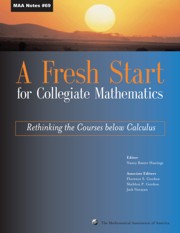Book contents
- Frontmatter
- Preface
- Contents
- Introduction
- Background
- Theme 1 New Visions for Introductory Collegiate Mathematics
- Theme 2 The Transition from High School to College
- Theme 3 The Needs of Other Disciplines
- Theme 4 Student Learning and Research
- Theme 5 Implementation
- Theme 6 Influencing the Mathematics Community
- Ideas and Projects that Work: Part 1
- Ideas and Projects that Work: Part 2
Theme 4 - Student Learning and Research
- Frontmatter
- Preface
- Contents
- Introduction
- Background
- Theme 1 New Visions for Introductory Collegiate Mathematics
- Theme 2 The Transition from High School to College
- Theme 3 The Needs of Other Disciplines
- Theme 4 Student Learning and Research
- Theme 5 Implementation
- Theme 6 Influencing the Mathematics Community
- Ideas and Projects that Work: Part 1
- Ideas and Projects that Work: Part 2
Summary
One line of questioning that was repeatedly voiced at the conference Rethinking the Preparation for Calculus revolved around determining what works and what doesn't work. Participants asked: “How can we determine whether or not new pedagogical approaches or new curricular materials are effective? How can we measure the impact of a new approach on student learning?” In order to convince colleagues to adopt new pedagogies and instructional materials, we not only need data to show that there is a problem, we also need to measure the effectiveness of alternative approaches. In this section, Florence Gordon looks at the results of a study that compared student performance, success, retention, and attitudes in a reform version of precalculus and in a traditional version of the same course. Rebecca Walker reports on the experiences of college students who prepared to continue their study of mathematics in a reformed high school environment.
Florence Gordon reports that in the fall of 1999, when some mathematics faculty at NYIT decided to teach a reform version of precalculus, several other faculty members objected to the change. As a result, the department decided to compare the performances of students in two traditional and two reform sections of precalculus.
For the last decade, the reform of mathematics education at the college level has been accompanied by the so-called “math wars.” One dimension of this struggle has involved calls to prove that non-traditional courses are at least as effective as the courses they are designed to replace. […]
- Type
- Chapter
- Information
- A Fresh Start for Collegiate MathematicsRethinking the Courses below Calculus, pp. 179 - 180Publisher: Mathematical Association of AmericaPrint publication year: 2006



